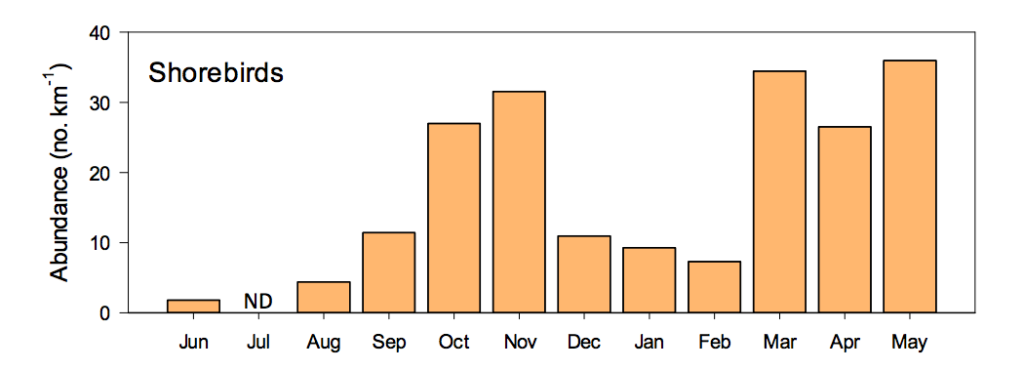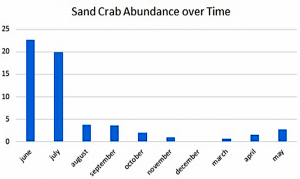Julian, Lucas, and Lily
Bishop O’Dowd High School
Sand crabs are herbivores and an important food source for other beach organisms, specifically shorebirds. We assumed that if the sand crab population is thriving on a beach, then the shorebird population should be doing well too. We looked at data of sand crabs and shorebirds along the north-central California coast over the course of a year. Our original hypothesis was that if the population of sand crabs was high, then naturally the population of shorebirds would also be high. But, contrary to our hypothesis, a flourishing sand crab population means there are less shorebirds…
For our field work, we participated in the LiMPETS Sandy Beach Monitoring Program. Using the same protocols that thousands of students use up and down the California coast, we sampled sand crabs on Ocean Beach in September. We then looked at sand crab population data from Ocean Beach on the LiMPETS database.
Then we compared LiMPETS data to shorebirds data. Overall, there tended to be a smaller sand crab population when there was a large shorebird population, particularly during the months of October, November, March, April, and May. In turn, during the other months when the shorebird population was significantly lower, the sand crab population was higher.

Using LiMPETS raw data, we averaged the densities of sand crabs of each month in 2013 by abundance in square meters. The data clearly shows a strong correlation between the summer months and an increase in the population of sand crabs. At the same time, the data in figure 2 shows that shorebirds are least abundant during the summer months. It seems that our hypothesis was incorrect.
We questioned why this inverse correlation existed. Maybe it wasn’t the sand crabs that determined the shorebird population, but something else. After further investigation, we learned that shorebirds migrate north in the summer months to breed and south in the winter. This led us to the conclusion that shorebirds have an effect on the sand crab population! If the shorebird population is abundant, they will be consuming much more sand crabs so therefore, the sand crab population will decrease.
But what about birds that don’t migrate? How does predation from not only shorebirds but also other birds such as mallards and ravens affect the sand crab population? Shorebirds are typically the main predator of sand crabs, but recently, other species such as mallards and ravens have been observed feeding on the sand crab population. Scientists surveyed the hunting behavior of common ravens, which were found to go after female sand crabs with eggs. Mallards have been observed preying on sandcrabs. Ravens and mallards do not migrate, meaning that sand crabs could be a constant food source for these birds.
This scenario could potentially take place at Ocean Beach. When we were at Ocean Beach in September, we found a multitude of sand crabs, especially females with eggs. What if ravens on Ocean Beach learned to eat sand crabs? This would be a year-long predator and might change the ups and downs of the sand crab population.

A raven eating a mole crab. Gathered from this source.



































How fortunate you are to have had this experience! Keep working in the field of marine science. We need scientists like you!
Great blog! It makes sense when you say that if the sand crab population is thriving on a beach, then the shorebird population should be doing well too because they feed on crabs. Because of this, it is interesting that you found out that when the sand crab population flourished than there are less shorebirds. When the shorebird population is abundant and they are consuming more sand crabs then the sand crab population will decrease contrary to our original hypothesis. My favorite part of your blog was how you proposed a question at the end for the reader to think about. This made your blog memorable and I learned a lot!